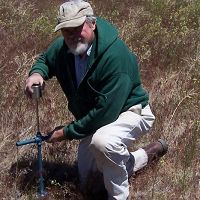Johnson et al., 2010
Spatial Nutrient Variability in a Sierran Forest Soil: an Investigation into the Nature and Potential Causes of Nutrient Hot Spots.
Johnson, D.W., Miller, W.W., Rau, B.M., Meadows, M.W. (2010)
Fall Meeting, American Geophysical Union, December 2010. Abstract EP42A-05.
-
Sierra, INVESTIGATOR
-
Sierra, COLLABORATOR
-
Sierra, STAFF
Abstract
Because of the extremely dry summers, rooting is entirely absent in the O horizons of many forest ecosystems in the eastern Sierra Nevada Mountains of Nevada and California. Thus, decomposition/N mineralization and vegetation uptake processes are spatially discoupled, and the intense competition for N between roots and decomposers in the O horizon which characterizes more humid forest ecosystems is absent. Because of this discoupling, the N returned in littterfall is not recycled to the trees until: 1) N supply exceeds microbial demand, and 2) N is leached to lower horizons where roots are present. Both O horizons and the mineral soil surface in these ecosystems are extremely hydrophobic in summer, restricting the ability of summer rainfall to wet underlying mineral soils except via preferential flowpaths. Recent studies have found very high concentrations of ionic forms of N in O horizon interflow solutions that flow over the top of mineral soils. We hypothesize that this O horizon interflow creates biogeochemical “hot spots” where it infiltrates into preferential flowpaths present in the mineral soil (Bundt et al., 2001). This paper reports the results of a study aimed at detecting O horizon runoff and nutrient hot spots in soils of the King’s River Experimental Watershed (KREW) in the western Sierra Nevada Mountains of California, one of the Critical Zone Observatory sites. Over two winter seasons, we found substantial amounts of O horizon interflow, some of which was highly enriched in inorganic forms of N and P. Measurements of nutrient variability by resin based collectors and coring within in small plots (6 x 6 m) revealed the presence of hot spots (defined as statistical outliers) and a varying degrees of positive skew for all measured nutrients, with the degree of skew and prevalence of hotspots being greater with weaker extractants. For example, skew was greatest and the hotspots were most prevalent for water soluble ammonium and nitrate, less for KCl-extractable ammonium and nitrate, and least for total N in soils. Similarly, skew was greater and hotspots more prevalent for water-soluble K, Ca, and Mg than for exchangeable forms. Hot spots for soil ammonium and nitrate were not related to total soil N or C:N ratio, nor were hot spots in mineral soils spatially correlated with those in overlying O horizons. There was, however, a pattern wherein thicker the O horizons were associated with lower the soil nutrient concentrations. One and only one hotspot was characterized by the highest concentrations of all measured water-extractable nutrients other than ortho-P, where it was second highest. We hypothesize that this was created by preferential infiltration of nutrient-rich O horizon interflow.
Citation
Johnson, D.W., Miller, W.W., Rau, B.M., Meadows, M.W. (2010): Spatial Nutrient Variability in a Sierran Forest Soil: an Investigation into the Nature and Potential Causes of Nutrient Hot Spots . Fall Meeting, American Geophysical Union, December 2010. Abstract EP42A-05..
Explore Further



